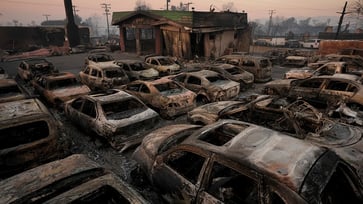5 lesser-known facts about Earth Day
One of the worst ecological disasters in US history served as the inspiration for Earth Day.

One of the most widely celebrated nonreligious holidays globally is Earth Day.
By 2009, Earth Day gained recognition from the United Nations, despite being primarily based in the United States.
The Clean Air Act, the Clean Water Act, and the Endangered Species Act are just a few of the crucial laws that have been enacted due to Earth Day's influence.
Earth Day is a popular holiday, but its history is not as widely known as its significance.
Here are five facts to know.
1. Earth Day is the most popular secular holiday in the world
Nearly 200 countries recognize Earth Day, which is celebrated by over a billion people annually.
Annually, over 95% of US primary and secondary education institutions participate in the holiday celebration.

Earth Day, celebrated worldwide, has become the most widely observed secular holiday, motivating global environmental conservation efforts.
2. An oil spill led to the creation of Earth Day
The founder of Earth Day was Democrat Wisconsin Sen. Gaylord Nelson.
One of the worst ecological disasters in U.S. history served as the inspiration for the holiday.
In January 1969, an oil well located off the coast of California, near Santa Barbara, erupted, releasing over 3 million gallons of oil into the Pacific Ocean.
Over 10,000 dolphins, seals, sea lions, and seabirds were killed by the disaster, prompting an outcry from environmental activists.
Nelson opted to examine the damage inflicted on sea life by the oil platform through an aerial inspection.
Nelson, inspired by what he saw, collaborated with environmental advocates to establish the first Earth Day observance.
Nelson and other individuals aimed to inform Americans about their influence on the planet's environment to facilitate the enactment of new environmental laws. Notable activists, including Marc McGinnes and Selma Rubin, supported Nelson's initiative to establish the observance.

The oil disaster on Jan. 1969 stunned the country and prompted the enactment of stricter government regulations on the oil industry to prevent future catastrophes of the same magnitude.
The establishment of the Environmental Protection Agency and the National Oceanic and Atmospheric Administration was motivated by the public outcry and celebration of Earth Day.
3. Nearly 10% of the U.S. population celebrated the first Earth Day
Denis Hayes, a young activist, collaborated with Nelson to organize the first Earth Day, which took place mainly in the United States, through a series of educational events, demonstrations, and marches nationwide.
Nelson chose to organize the first Earth Day on April 22 as it coincided with the break between spring exams and final exams for most college students.
The enthusiasm and support for young people were crucial and led to new environmental safety regulations and agencies.
He aimed to draw in a large number of young individuals to back the event.

The first Earth Day, organized by a group of activists, quickly grew into a nationwide event that attracted more than 20 million participants and became the largest protest in history.
In 1970, over 12,000 educational institutions, including labor unions and anti-war activists, took part in Earth Day celebrations and protests.
New environmental safety regulations and agencies were established due to the vital support and encouragement for young people.
Approximately 10% of the U.S. population participated in the first Earth Day.
4. Earth Day went truly global in 1990
Nelson, who helped organize the first Earth Day with Hayes, was approached to lead another campaign for Earth Day's 20th anniversary. What resulted was a massive campaign spanning 141 countries that mobilized 200 million people.
The campaign, backed by the marketing power of television, radio, and a substantial budget, brought global attention to environmental problems, boosting recycling efforts worldwide and paving the way for the 1992 United Nations Earth Summit in Rio de Janeiro.
In 1990, Earth Day inspired President Clinton to award Nelson the Presidential Medal of Freedom, the highest civilian honor in the US, for his work in establishing Earth Day.

5. Significant U.N. climate legislation began on Earth Day
The Paris Agreement is a legally binding international treaty under the United Nations Framework Convention on Climate Change, which was opened for signature at the U.N. Headquarters in New York City on Earth Day in 2016.
The Paris Agreement entered into force on Nov. 4, 2016.
Today, 195 parties have signed and ratified the agreement.
The objective is to keep global temperature increase below 2 degrees Celsius, with a preference for no more than 1.5 degrees.
Phillip Nieto contributed reporting.
For more Lifestyle articles, visit planetchronicle.net/lifestyle.
lifestyle
You might also like
- Post-inauguration, the surprising truths about DC travel costs.
- Melania and Donald Trump celebrate their 20th wedding anniversary: View the images.
- John Schneider, known for his role in 'Dukes of Hazzard,' remains steadfast in his belief: "God has a plan."
- Notre Dame football coach and Catholic convert is 'not shy about' the importance of faith.
- Trump confidant and unofficial spiritual advisor: "God is granting America another opportunity"



















